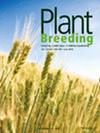Genome‐Wide Association Study Reveals Candidate Genes Controlling Tillering and Effective Panicle Number in Rice (Oryza sativa L.)
IF 1.8
4区 农林科学
Q2 AGRONOMY
引用次数: 0
Abstract
Tiller number and effective panicle number are important factors affecting rice yield. In this study, the sequencing data of 331 rice varieties were used to carry out genome‐wide association study (GWAS) of these two factors. A total of 58 candidate genes related to tiller number were identified, and their functions involved energy metabolism and cytoplasmic membrane metabolism pathways. There were 19 candidate genes related to effective panicle number, whose functions involved energy metabolism, cytoplasmic membrane metabolism and signal transduction pathways. A new QTL ‘全基因组关联研究揭示控制水稻(Oryza sativa L.)分蘖和有效圆锥花序数的候选基因
分蘖数和有效圆锥花序数是影响水稻产量的重要因素。本研究利用 331 个水稻品种的测序数据对这两个因子进行了全基因组关联研究(GWAS)。共鉴定出 58 个与分蘖数相关的候选基因,其功能涉及能量代谢和细胞质膜代谢途径。与有效圆锥花序数相关的候选基因有19个,其功能涉及能量代谢、细胞质膜代谢和信号转导途径。在第 12 号染色体上发现了一个新的 QTL "qTNP12",它同时控制分蘖数和有效圆锥花序数。候选基因编码框中的第 275 个氨基酸存在特异性变异。多分蘖的籼稻有组氨酸变异,而少分蘖的粳稻和糙米有精氨酸变异。进化分析表明,籼稻的多分蘖性状是通过人工选择和驯化形成的。本研究的结果为进一步阐明 qTPN12 调控分蘖和有效圆锥花序的分子机制,以及通过分子标记辅助选择改善水稻结构奠定了基础。
本文章由计算机程序翻译,如有差异,请以英文原文为准。
求助全文
约1分钟内获得全文
求助全文
来源期刊

Plant Breeding
农林科学-农艺学
CiteScore
4.40
自引率
5.00%
发文量
74
审稿时长
3.0 months
期刊介绍:
PLANT BREEDING publishes full-length original manuscripts and review articles on all aspects of plant improvement, breeding methodologies, and genetics to include qualitative and quantitative inheritance and genomics of major crop species. PLANT BREEDING provides readers with cutting-edge information on use of molecular techniques and genomics as they relate to improving gain from selection. Since its subject matter embraces all aspects of crop improvement, its content is sought after by both industry and academia. Fields of interest: Genetics of cultivated plants as well as research in practical plant breeding.
 求助内容:
求助内容: 应助结果提醒方式:
应助结果提醒方式:


